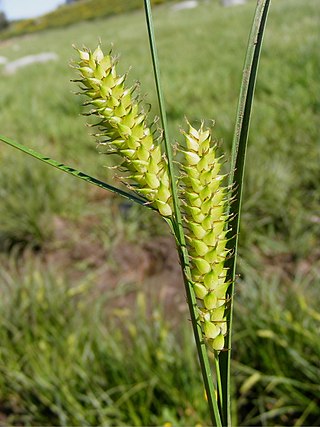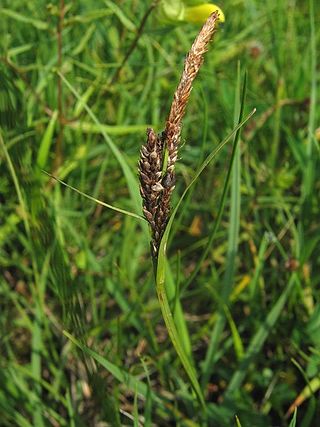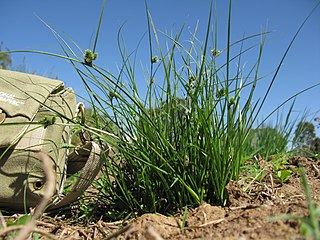
The Cyperaceae are a family of graminoid (grass-like), monocotyledonous flowering plants known as sedges. The family is large: botanists have described some 5,500 known species in about 90 genera, the largest being the "true sedges" with over 2,000 species.

Carex pendula is a large sedge of the genus Carex. It occurs in woodland, scrubland, hedges and beside streams, preferring damp, heavy clay soils. It is sometimes grown as a garden plant because of its distinctive appearance.

Mesomelaena is a genus of sedges. It has 5 known species, all endemic to Western Australia.

Carex vesicaria is an essentially Holarctic species of sedge known as bladder sedge, inflated sedge, and blister sedge. It has been used to insulate footwear in Norway and among the Sami people, and for basketry in North America.

Carex pensylvanica is a species of flowering plant in the sedge family commonly called Pennsylvania sedge. Other common names include early sedge, common oak sedge, and yellow sedge.

Carex panicea, commonly known as carnation sedge, is a plant species in the sedge family, Cyperaceae. It is known as grass-like sedge and can be found in Northern and Western Europe, and also in north-eastern North America. The plant produces fruits which are 3–4 millimetres (0.12–0.16 in) long, are egg shaped and spiked. Both male and female species leaves are pale blue on both sides.
Baumea preissii is a flowering plant in the sedge family Cyperaceae, which is native to Western Australia.

Carex fascicularis, commonly known as tassel sedge, is a species of sedge of the family Cyperaceae that is native to Australia, New Zealand and New Guinea.

Carex inversa, commonly known as knob sedge, is a species of sedge of the family Cyperaceae that is native to parts of Australia and New Zealand and has also been introduced into Great Britain.

Carex pumila, commonly known as strand sedge or spreading sedge, is a species of sedge of the family Cyperaceae.
Carex tereticaulis, also known as basket sedge, is a species of sedge of the family Cyperaceae that is native to southern parts of Western Australia, southern parts of South Australia, southern and eastern parts of New South Wales as well as north western and central Victoria and Tasmania. The Koori peoples know the plant as Poong'ort.
Carex caespititia, also known as cong sheng tai cao, is a tussock-forming species of perennial sedge in the family Cyperaceae. It is native to parts of Asia from Assam in northern India in the west to central China in the east.

Carex cruenta is a tussock-forming species of perennial sedge in the family Cyperaceae. It is native to parts of Asia, from Pakistan in the west to south central parts of China in the east.

Carex meyenii, commonly known as Meyen's sedge, is a tussock-forming species of perennial sedge in the family Cyperaceae. It is native to parts of Hawaii.

Carex parva, also known to Chinese people as xiao tai cao, is a tussock-forming species of perennial sedge in the family Cyperaceae. It is native to parts of Asia from Afghanistan to Mongolia.
Carex vulpinaris is a tussock-forming species of perennial sedge in the family Cyperaceae. It is native to parts of South Asia and Central Asia including Afghanistan, Tajikistan and Pakistan westerns parts of the Himalaya.

Carex leersii, the grassland sedge or many-leaved sedge, is a widespread species of flowering plant in the family Cyperaceae. It is native to the Atlas Mountains in Africa, Europe, the Middle East, Central Asia, the Altai and the western Himalayas, and has been introduced to New Zealand. It is a member of the Carex muricata group, and prefers to grow in sunny, relatively dry locations.
Carex xerantica, the dry sedge, dryland sedge, or white-scaled sedge, is a species of flowering plant in the family Cyperaceae, native to western and central Canada, and the north-central United States. It can be found in a wide variety of habitats, including meadows, prairies, open woodlands, bluffs, sandy or rocky areas, and even talus slopes.












